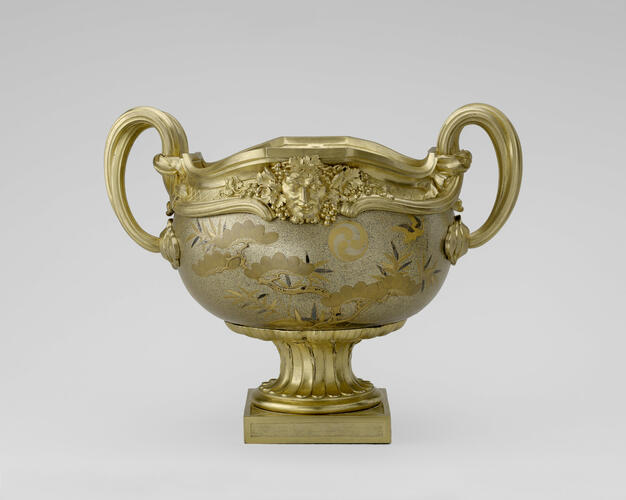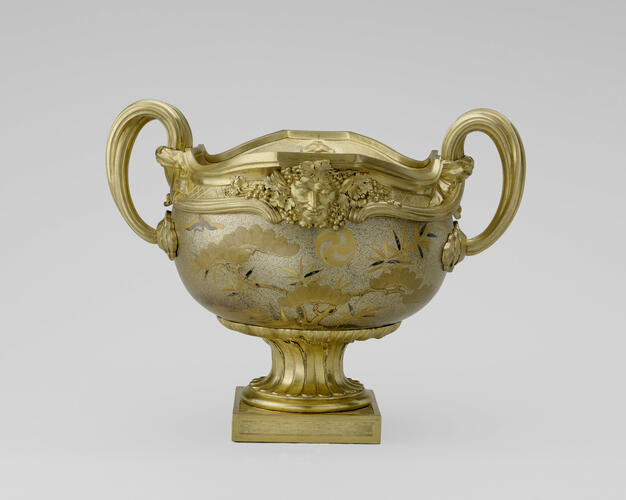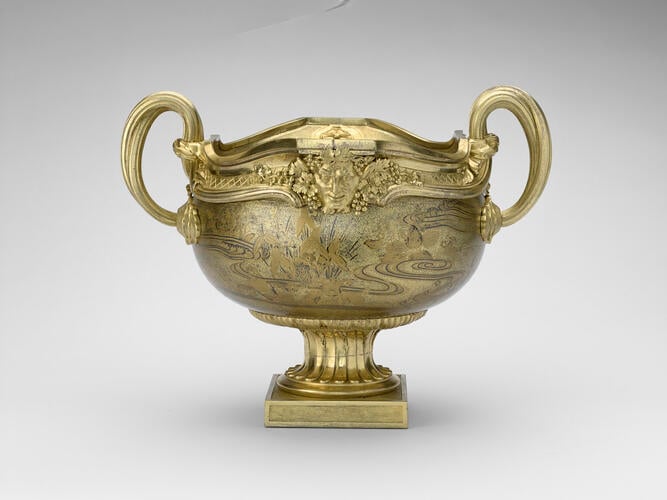-
1 of 253523 objects
Pair of mounted bowls lacquer: 1680-1720, mounts: 1750-1775
Wood decorated in black and gold lacquer, mounted in gilt bronze | 31.7 x 39.6 x 38.1 cm (whole object) | RCIN 3154

Japan
Master: Pair of mounted bowls Item: Mounted bowl lacquer: 1680-1720, mounts: 1750-1775

Japan
Master: Pair of mounted bowls Item: Mounted bowl lacquer: 1680-1720, mounts: 1750-1775

Japan
Master: Pair of mounted bowls Item: Mounted bowl lacquer: 1680-1720, mounts: 1750-1775

Japan
Master: Pair of mounted bowls Item: Mounted bowl lacquer: 1680-1720, mounts: 1750-1775

Japan
Master: Pair of mounted bowls Item: Mounted bowl lacquer: 1680-1720, mounts: 1750-1775

Japan
Master: Pair of mounted bowls Item: Mounted bowl lacquer: 1680-1720, mounts: 1750-1775






-
Pair of Japanese lacquered bowls with French-gilt bronze mounts, rounded sides curving in towards the lip. On the outside of RCIN 3154.1, a design outlined in black and gold on a fundame ground, with swirling mist encircling islands of growing lotus, reeds and other plants, with some leaves in raised relief; inside, a similar design. RCIN 3154.2 shows, on one side, pine and bamboo growing on an island and two mon emblems, and the other side continues the mythological theme with a crane, a minogame or ‘flaming turtle’ (both further symbols of longevity), and a single mon. The identical gilt-bronze mounts comprising a scrolling rim with Bacchus masks before and behind issuing grapes, vine leaves and tendrils, with a hatched and pounced ground below the thickly cast upper moulded edge. At each side, twisted, fluted and overlapping ribbon-tied stem loop handles, which descend into overlapping quatrefoils. The interior of the mouth rim with pounced panels, and behind each Bacchus mask, a large quatrefoil nut. Where the side handles pierce the lower part of the bowl, a smaller corresponding quatrefoil nut on the inside. The bowl supported on a spiral, shallow-fluted socle with foliage, on a square plinth with pounced panels with burnished borders. The bowl’s foot and handles cut to accommodate the mounts.
These bowls combine Japanese lacquer and French mounts of equally high quality. Wares of this class were not made for official export, and their arrival in Europe is testament to the largely undocumented private trade which took place among members of the EIC and VOC. One bowl is decorated with designs derived from Buddhist iconography: the lotus is the seat of the meditating Buddha and represents purity and enlightenment amid the swirling mists and swamp. The second bowl is replete with symbols of longevity, including cranes, pine trees and the mythical minogame tortoise. The tomoe (triple comma) mon appears on both sides. This symbol was used to decorate domestic wares and shrine architecture from the Kamakura period (1185–1333) onwards, and was also incorporated in numerous crests, making it difficult to link the bowl to a specific family.
The bowls originally functioned as water basins (mimidarai) with wooden handles. Perhaps inspired by Japanese motifs, the French mount designer has incorporated stylised clouds or petals where the new gilt-bronze handles join the bowl. However, the dominant forms are large masks of Bacchus, the Greco-Roman god of fruitfulness, who is associated with wine and ecstatic pleasure. One of Bacchus’s personal attributes was a deep two-handled goblet with loop-shaped handles called a kantharos: the mounts here are a clear reference to this form, subsuming a Japanese lacquer piece within the classical canon beloved of eighteenth-century Europe.
George IV acquired the mounted bowls before 1826, when they were depicted in the Library at the Royal Pavilion, Brighton.
Text adapted from Royal Treasures, A Golden Jubilee Celebration, London 2002, Gold, London 2014, Chinese and Japanese Works of Art in the Collection of Her Majesty The Queen: Volume III and Japan: Courts and Culture, 2020.
Provenance
Acquired by George IV, before 1824. One recorded in the Library at the Royal Pavilion, Brighton, as ‘A very fine circular gold spangled wood Japan bowl, raised leaves & flowers; finely mounted in chased scrolled rim, Satyr masks, fruited Vine leaves twisted handles and fluted stem, on a square panelled sanded base. Twelve inches [30.5 cm]’, and the other with similar description (1829B, p. 61); sent to Kensington Palace in June 1848 (1829A, p. 43). In 1914, noted in the East Wing (centre portion of the Principal Corridor), in the Brighton Pavilion Inventory of Clocks and China 1828, p. 95; and in 1921 in the Picture Gallery, Buckingham Palace (1829B, p. 61).
-
Creator(s)
(nationality)(metalworker)Acquirer(s)
-
Medium and techniques
Wood decorated in black and gold lacquer, mounted in gilt bronze
Measurements
31.7 x 39.6 x 38.1 cm (whole object)
29.8 x 39.6 x 38.1 cm (whole object)
Category
Subject(s)
Other number(s)
Place of Production
Japan